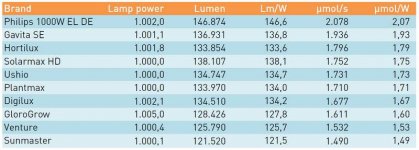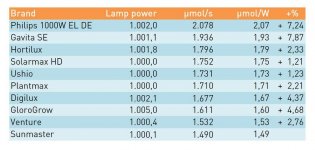that depends a lot on the color temperature and the make of the lamp: High color temperature lamps usually output less micromoles and MH in general do not have a good light maintenance. They drop up to 20%+ per year. The Philips HPI T-plus does initially 540 micromoles. That's 1.35 per watt at full power. After a year of 5000 hours us that would be 1.08. However... MH are usually use for veg, so 18 hours per day. A year 18 hours would be 6570 hours. You'd be looking at less than 80% light maintenance after a year use.
Not all HPS lamps have a good light maintenance either, but the quality horticultural lamps do not drop 20% per year.
We have seen HPS lamps that initially were very bright drop more than 5% over the first 3 months of use, about the same as the MH drop.
The new CMH lamps have a much better light maintenance than MH.
Not all HPS lamps have a good light maintenance either, but the quality horticultural lamps do not drop 20% per year.
We have seen HPS lamps that initially were very bright drop more than 5% over the first 3 months of use, about the same as the MH drop.
The new CMH lamps have a much better light maintenance than MH.




